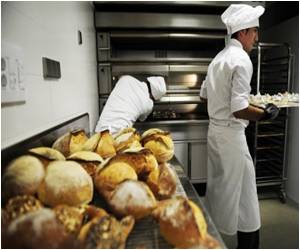It's your 150th day in space, and life is starting to resemble the movie Groundhog Day -- a repetitive daily routine interspersed with tugs of longing for life back on Earth.

Mission Control has declared that today will be a "special day," and you can look forward to a lip-smacking, finger-lickin'-good gourmet meal at the end of it.
This is where France's space chefs come in.
In an initiative backed by top-of-the-line cuisinier Alain Ducasse, a team of cooks design and make "Special Event Meals" -- SEMs -- to enliven the nutritious but often dull freeze-dried diet of life in space.
About once a month, as the distant Earth rolls slowly beneath them, astronauts can feast on roasted quail, Breton lobster, hand-reared chicken from the Landes, casserole of Burgundy beef cheek, Riviera-style swordfish or duck breast in a caper sauce.
Dessert could be a lemon cream cake, chocolate cake, or "millefeuille" (literally, "thousand-leaf") puff pastry with fruit and cream filling.
Advertisement
Rule no. 1 is safety, said Lionel Suchet, deputy head of France's Toulouse Space Centre, who launched the programme.
Advertisement
Another potential devil is texture. Ingredients that provide a pleasant feel in the mouth on Earth could be lethal in space, Suchet said.
"Food can't be too dry, breaking up into crumbs that astronauts can inhale," he said.
"At the same time, you can't have it too liquid. If food is too runny, you get 'Captain Haddock Syndrome'," Suchet said.
This was a reference to an episode in one of the Tintin cartoon books, where a character's whisky rolls up disconcertingly into a ball as their spaceship speeds to the Moon.
"Captain Haddock Syndrome" may sound fun... but the balls of liquid can cause short circuits if they touch electronic gear.
Then there is ease of use. The food must fit in ultra-light aluminium tins that can be reheated on an induction cooktop.
And the astronauts must be able to consume the contents one-handed, using a spoon. Anything with bits that are too big, too tiny, too fiddly or need to be cut is a no-no.
France's National Centre of Space Studies (CNES) has ordered up to 2,000 individual meals, from 25 recipes, for next year alone. They are certified by NASA for use aboard the International Space Station (ISS).
Henaff, a small pate-making company based at Pouldreuzic, Brittany, does the cooking, using a sterile chamber at its plant.
French culinary involvement in space dates back to 1993, when French astronaut Jean-Pierre Haignere returned from a mission aboard the Russian space station Mir.
Everything went well, but the food was another matter: day after day of black bread, cold herrings and tinned plasticky cheese... For any French palate, a cosmic nightmare.
In a rush of sympathy, Richard Filippi, a teacher at a restaurant school in Souillac -- appropriately in the foodie heartland of the Dordogne -- contacted the CNES, offering his help.
The meals proved an instant success. In 1997, when France was forced to cancel a manned mission to Mir, Russia's cosmonaut begged the CNES to send up the food anyway as they liked it so much.
"At this point, we discovered that there was an important issue at stake, not just in operational terms but also psychologically, for teams to meet for a good meal on special occasions," Suchet told AFP.
With Ducasse's help, the menu expanded to top-of-the-range offerings. SEMs were born in 2004, and five years later made their first appearance on the ISS.
The importance of festive meals is influencing preparations for manned missions to Mars.
Boredom and tensions between team members will be among the greatest obstacles on what is likely to be a round trip of two years in extreme confinement.
One idea is to have dishes that on "special days" pop out from secret compartments to provide crew with a tasty, morale-boosting surprise.
Source-AFP








